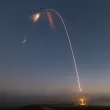Featured image credit: ROSCOSMOS
Lift Off Time | March 18, 2022 – 15:55 UTC | 18:55 MSK |
|---|---|
Mission Name | Soyuz MS-21, crewed flight to the International Space Station (ISS) |
Launch Provider | ROSCOSMOS |
Customer | ROSCOSMOS |
Rocket | Soyuz 2.1a |
Launch Location | Launch Complex 31/6, Baikonur Cosmodrome, Kazakhstan |
Payload mass | 7,080 kg (15,610 Ib) (for the whole spacecraft) |
Where did the spacecraft go? | It rendezvoused with the ISS, ~400 km low Earth orbit (LEO) at a 51.66° inclination |
Did they attempt to recover the first stage? | No, this is not a capability of Soyuz |
Where did the first stage land? | The boosters crashed into the steppes of Kazakhstan |
Did they attempt to recover the fairings? | No, this is not a capability of Soyuz |
Were these fairings new? | Yes |
This was the: | – 1st crewed launch of 2022 – 60th Soyuz 2.1a launch -149th flight of a crewed Soyuz spacecraft – 29th orbital launch attempt of 2022 |
Where to watch | If available, an official replay will be listed here |
How Did It Go?
ROSCOSMOS successfully launched Soyuz MS-21 to the International Space Station (ISS) on March 18, 2022. This launch saw three new crew members join the station, cosmonauts Oleg Artemyev, Denis Matveev, and Sergey Korsakov, marking the first mission to the ISS with three ROSCOSMOS cosmonauts. ROSCOSMOS launched this mission using a Soyuz MS spacecraft atop a Soyuz 2.1a launch vehicle, from Launch Complex 31/6, at the Baikonur Cosmodrome in Kazakhstan.
The mission used a fast rendezvous technique which meant the spacecraft manually docked to the ISS approximately three hours after liftoff. The mission is expected to last a little over 6 months, with the crew scheduled to return to Earth on September 29, 2022.

Who Is On Soyuz MS-21?
Unlike previous Soyuz crewed launches to the ISS, which have had astronauts from multiple countries occupy a seat, this launch was the first mission to the ISS comprised of three ROSCOSMOS cosmonauts. The crew, which was named in May 2021, is Oleg Artemyev (Commander), Denis Matveev (Flight Engineer 1), and Sergey Korsakov (Flight Engineer 2). The MS-21 backup crew is made up of Sergey Prokopyev (Commander), Anna Kikina (Flight Engineer 1), and Dmitriy Petelin (Flight Engineer 2).
Commander: Oleg Artemyev
MS-21 Commander Oleg Artemyev was born in 1970. Artemyev was selected for cosmonaut training in 2003. Before his first space flight Artemyev served as a crew member for the 15-day and 105-day precursor studies of the MARS-500 program, which he did between 2007 and 2009. This was a psychosocial isolation experiment done in preparation fir future crewed spaceflights to Mars.
Artemyev first flew to space in 2014 as a member of Expedition 39/40 to the ISS. Artemyev then flew for a second time for the Expedition 55/56 mission in 2018. Soyuz MS-21 marks Artemyev’s third journey to space.

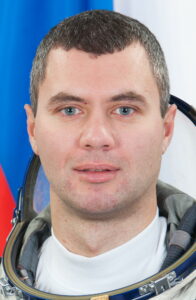
Flight Engineer 1: Denis Matveev
Cosmonaut Denis Matveev was born in 1983. He graduated from Bauman Moscow State Technical University in 2006, with a degree in Computing and Networks. Following this, Matveev worked as a research assistant at the Yuri Gagarin Cosmonaut Training Center.
Matveev was selected for cosmonaut training in 2010, and was appointed as a test cosmonaut in 2012. The Soyuz MS-21 mission was Matveev’s first journey to space.
Flight Engineer 2: Sergey Korsakov
Sergey Korsakov is a Russian cosmonaut, born in 1984. Just like his crew mate Denis Matveev, Korsakov also graduated from the Bauman Moscow State Technical University in 2006, but this time with a degree in rocketry.
Korsakov was selected for cosmonaut training in 2012, and was then appointed as a test cosmonaut in 2014. Like Matveev, the Soyuz MS-21 mission was also Korsakov’s first space flight.

Soyuz MS-21 Mission’s Profile
Approximate Timeline (Based On The Soyuz MS-18 Mission)
| Hrs:Min:Sec From Lift-Off | Events |
| – 00:00:15 | Engine start sequence |
| 00:00:00 | Lift-Off |
| + 00:01:53 | Escape tower jettison |
| + 00:01:58 | First stage separation |
| + 00:02:33 | Fairing jettison |
| + 00:04:47 | Second stage separation |
| + 00:04:55 | Tail section separation |
| + 00:08:46 | Third stage main engine cutoff |
| + 00:08:49 | Soyuz MS separation |
What Is Soyuz 2.1a?
ROSCOSMOS’s Soyuz is a multi-use medium-lift launch vehicle that was introduced in far 1966 and since then has been the workhorse of the Soviet/Russian space program. It is capable to launch civilian and military satellites, as well as cargo and crewed missions to the ISS. Over the decades, several variants of the Soyuz rocket have been developed. Soyuz 2.1a is one of its latest iterations that belongs to the Soyuz-2 rocket family.

The rocket consists of three stages, all of them are expendable. When launching to the ISS, Soyuz-2 can be flown with either a Progress capsule or a Soyuz spacecraft. On the Soyuz MS-21 mission, the Soyuz MS spacecraft was used.
Soyuz 2.1a is about 46.3 meters (152 ft) in height and 2.95 meters (9 feet) in diameter. The vehicle’s total lift-off mass is approximately 312,000 kg (688,000 lb). The rocket’s payload lift capacity to low-Earth orbit (LEO) is between 6,600 and 7,400 kg depending on the launch site.
Stages
| First Stage | Second Stage | Third Stage | |
| Engine | 4 RD-107A | RD-108A | RD-0110 |
| Total Thrust | 840 kN (188,720 lbf), sea level 1,020 kN (229,290 lbf), vacuum | 792 kN (178,140 lbf), sea level 922 kN (207,240 lbf), vacuum | 298 kN (67,000 lbf), vacuum |
| Specific Impulse (ISP) | 263 s, sea level 320 s, vacuum | 258 s, sea level 321 s, vacuum | 326 s, vacuum |
Side Boosters
The first stage of the Soyuz 2.1a rocket is composed of four side boosters that are powered by RD-107A engines. Each one of the boosters has a conical shape and a dry weight of 3,784 kg. It is approximately 19.6 meters in length, with a diameter of 2.7 meters. Each side booster has two vernier thrusters that are used for flight control.
The RD-107A engine runs on rocket-grade kerosene (RP-1) and liquid oxygen (LOx). The propellants are stored in the pressurized aluminum alloy tanks, the kerosene tank is located in the cylindrical part of the booster, and the LOx one is in the conical section. Each one of those engines has four combustion chambers and together they are capable of producing a thrust of 840 kN at sea level and 1,020 kN in a vacuum.
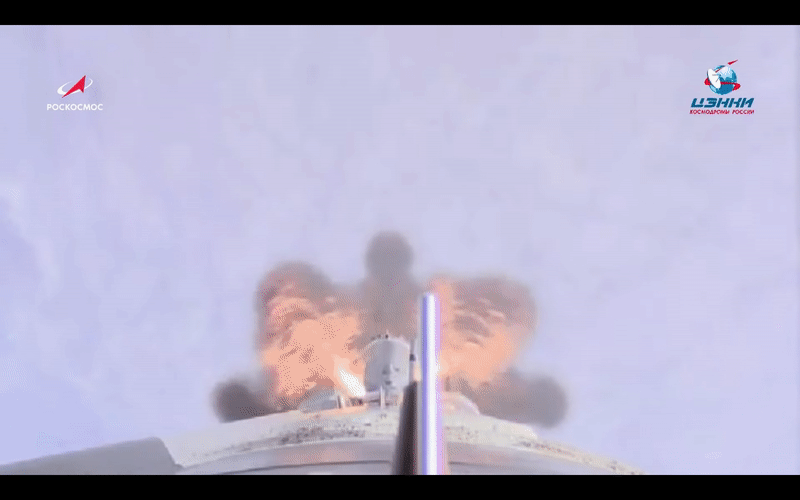
Perhaps, the most spectacular moment of the Soyuz-2 rocket’s launch is the separation of the first stage. It happens approximately two minutes after the launch. The boosters perform a pattern, known as the “Korolev cross” (named after Sergei Korolev, a very important figure of the USSR space program and history).
Second And Third Stages
The center core stage is powered by a single RD-108A engine, and the upper stage is fitted with a single RD-0110 engine. Both of these engines run on rocket-grade kerosene and LOx and have four combustion chambers. The second stage is 27.10 meters long, with a diameter of 2.95 meters, and a dry mass of 6,545 kg. It has four vernier thrusters for three-axis flight control.
The third stage of a Soyuz-2 rocket has a height of 6.7 meters, a diameter of 2.7 meters, and a dry mass of 2,355 kg. One interesting thing about the engine on this stage is that it starts its ignition sequence prior to stage separation. This process is called “hot fire staging”.
Soyuz MS Spacecraft
The Soyuz MS spacecraft is the latest version of Russia’s long-standing three-person spacecraft. Soyuz capsules first flew in the 1960s. The spacecraft’s external appearance is largely unchanged over this time. However, the internal systems and capabilities have been upgraded many times.

The Soyuz MS variant is one of the versions from the fourth generation of this spacecraft. Its first flight was in 2006. Soyuz consists of three sections:
- the orbital module
- the descent module
- the service module
The Orbital Module
This is the forward section of the spacecraft, the part that docks to the ISS. It is the part of the spacecraft where the crew will spend most of their time on orbit. It has more living room than the descent module. On the Progress uncrewed resupply missions, this is replaced by a cargo module.
The Descent Module
This is the middle section of the spacecraft. It is the only part that returns intact to land on Earth. This is where the crew will sit during the launch and the reentry. They will be wearing spacesuits in case of capsule depressurization. There is very little room for the crew of three in this module. On the Progress uncrewed resupply missions, this is replaced by a refueling module that can transfer fuel into the Russian segment. This can then be used by thrusters on the ISS to boost its orbit.
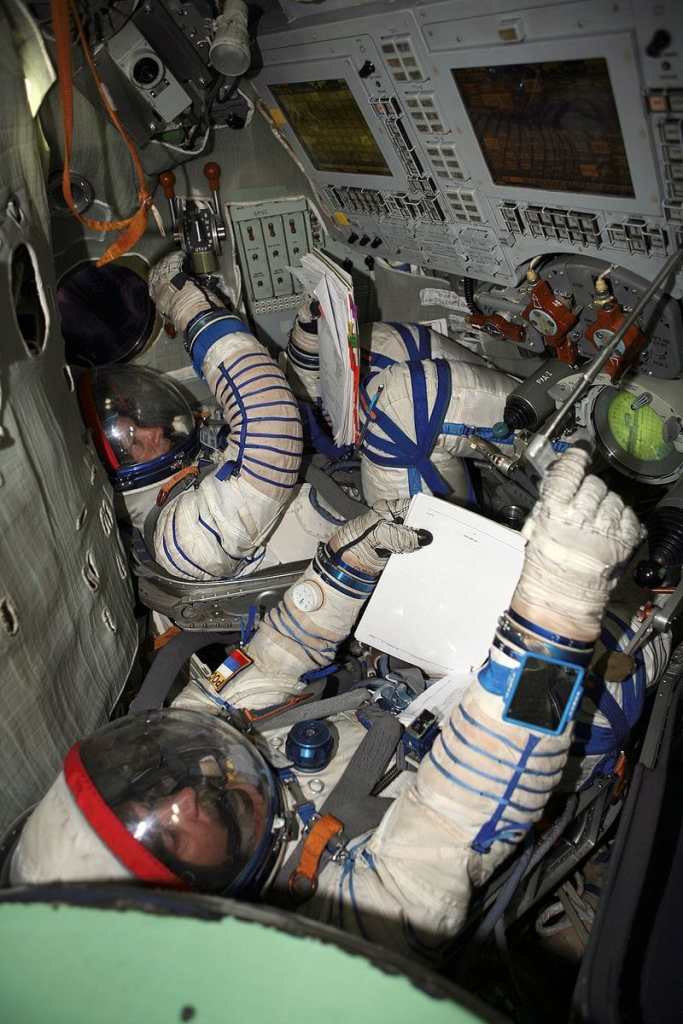
The Service Module
This is the aft (rear) section of the spacecraft. It provides the main engine used for manoeuvring on orbit and the thrusters for fine control during docking and departure. Also, it also contains the life support system for environmental control of the rest of the spacecraft. In addition, it also supports the solar panels and various radio communication systems.
Kurs-NA Automatic Docking System
Like the Soyuz spacecraft, Progress MS is equipped with a Kurs-NA automatic docking system that was first tested on the Progress M-15M mission in July 2012. Compared to its ancestor, Kurs-A, the new system has only one AO-753A rendezvous antenna. Kurs-A had five (two 2AO-VKA and three AKR-VKA) of them. This antenna broadcasts radar pulses that are needed to determine the altitude and relative position of the spacecraft to the ISS. Moreover, Kurs-NA uses less power than Kurs-A.
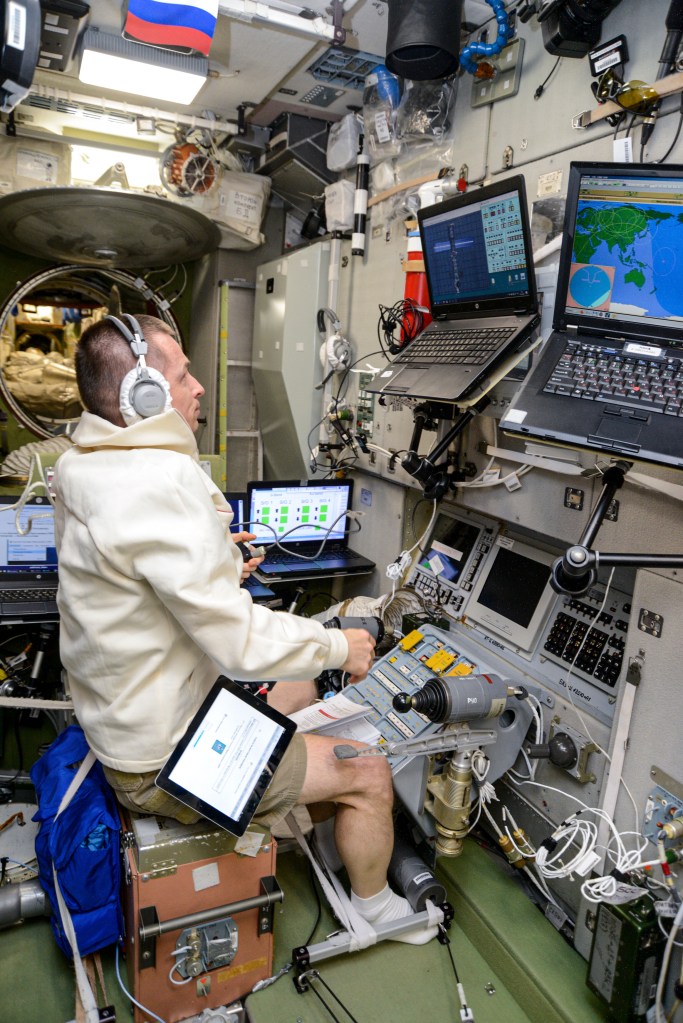
In addition, the Soyuz spacecraft can be docked to the ISS manually by the docking system called the Tele-Robotically Operated Rendezvous unit (TORU). This manual system serves as a backup to Kurs-NA in emergency situations and is located inside the Zvezda service module.
Rocket section adapted from Mariia Kiseleva

